The Chief Executive Tony Davis of Singapore based low-cost airline Tiger Airways said that they want to be the Ryanair of Asia. Tiger Airways flies from Singapore to Macau, Thailand, Vietnam, Indonesia and the Philippines, competing with Malaysia's AirAsia and a partnership of Valueair Ltd and Qantas Airways associate Jetstar Asia. Tiger is 49 per cent owned by Singapore Airlines.
Category Archives: enewsletter
Exploding Python Ate Alligator
Alligators have clashed with non native pythons before in Everglades National Park. A 13 ft long python tried to swallow a 6 ft alligator whole and then exploded. Scientists have documented four similar encounters in the last three years. The encroachment of Burmese pythons into the Everglades could threaten an $8 billion restoration project and endanger smaller species, said Frank Mazzotti, a University of Florida wildlife professor. The gators have had to share their territory with a python population that has swelled over the past 20 years after owners dropped off pythons they no longer wanted in the Everglades. The Asian snakes have thrived in the wet, hot climate. “Encounters like that are almost never seen in the wild – and we here are, it's happened for the fourth time,” Mazzotti said. In the other cases, the alligator won or the battle was an apparent draw.
Meeting News from Ontario
For information on Ontario meetings, please contact Svatka Hermanek: shermanek@schulich.yorku.ca or Bruce Weber: tel. 416-203-0911 or Paul Webb: tel. 416-694-8259.
Meetings are held on the third Friday of January, March, May, September and November. Usually at the Woodsworth Co-op, Penthouse, 133, Wilton Street in downtown Toronto at 8.00 p.m.
Heathrow Terminal 5
Terminal 5, whose sole tenant is British Airways is due to open on Sunday, 30 March 2008. The £4.2bn project is intended to bring some … to your transit. Never mind the passenger experience; your baggage will have a first-class journey. Amazingly, Terminal 5 is said to be Europe's biggest construction project.
Mutual Aid
Need help? Want a travelling buddy or advice about a place or country – want to share something with us – why not visit our Mutual Aid section of the Website: Mutual Aid
Padmasana Visits London Open House
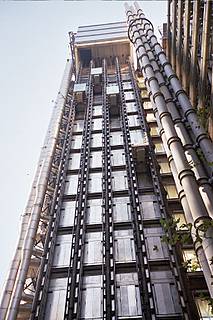 London Open
House day back in September was lovely and sunny. The Beetle was
not in the country to accompany Padmasana as she usually does, to
various places around central London to look around buildings
opened to the public for one or two days only, culminating in a
good fry up at the 24hr greasy spoon café in Smithfield. Next
year, maybe!
London Open
House day back in September was lovely and sunny. The Beetle was
not in the country to accompany Padmasana as she usually does, to
various places around central London to look around buildings
opened to the public for one or two days only, culminating in a
good fry up at the 24hr greasy spoon café in Smithfield. Next
year, maybe!
Got the bus down to Liverpool Street, walked past the Gherkin
(unsurprisingly not open this year, after the various states of
security alerts London has had in recent months) and got in the
queue for the Lloyd's Building. There was a long line of
people, but it moved surprisingly quickly, and took 45 minutes to
get to the front, where there was a stringent security check
before being allowed up the escalator into “The Room”.
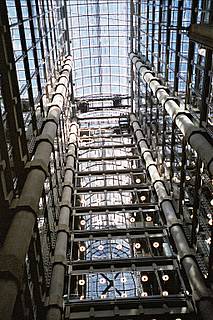
It's certainly impressive, a wonderful building and very modern. Saw the Lutine Bell and they also let you look through the “Losses” book: no sinkings that week, but there was one the week before, still entered in the massive book with a quill pen. Then you get a go in the fantastic “outside” lifts, up to the top, stunning views of the city, saw the dining room, lots of silver stuff, but the carpet was a little old and threadbare! It was a well organised tour and all too soon came to the end, so a speedy ride back in the outside lift down the outside of the building, which deposits you in a coffee/gift shop. It was well worth the queuing.
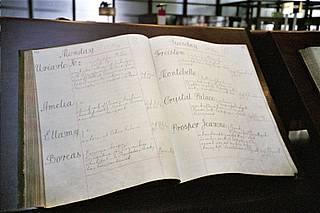 I then
walked along Fenchurch Street to number 60, where there were no
lines at the Vitro building, so was able to go straight up in the
lift to the 11th floor to see great views of the Tower of London,
the Gherkin and I could even see the London Eye.
I then
walked along Fenchurch Street to number 60, where there were no
lines at the Vitro building, so was able to go straight up in the
lift to the 11th floor to see great views of the Tower of London,
the Gherkin and I could even see the London Eye.
Then headed towards the Guildhall, went past the Bank of England,
humongous queues this year, people waited up to 3 hours, glad we
did that one last year, soon found the “Touch London”
exhibit. This is a scale model of the city, with all the
buildings done to scale. Then saw there were no queues for the
Guildhall itself, so I went in; it was fascinating seeing all the
stained glass windows with all the different occupations. I liked
the “Fletchers” window best of all, with its
arrows.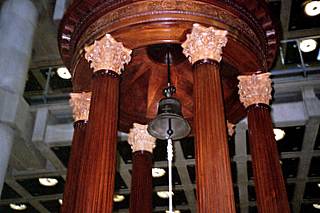
Quick pit stop in Tesco's on Cheapside then on to the Royal Exchange to do the “City alleyways” walk with the London Guide. There were way too many people and the guide was barely audible above the traffic, but once we got going it was a fascinating 2 hours. I saw the door to the shop (now an optician) where Harry Potter went to buy his wand! Leadenhall market was interesting, this used to be a chicken market. Allegedly, a stroppy chicken refused to take its final journey and ended up being a pet to the people who worked there and when it eventually croaked, it had a state funeral! Eventually ended up near The Tower of London via St Dunstans. It was a really lovely interesting walk, though would have been better if they had done more of them to spread the crowds out a bit though!
Open House Londonis the Capital's biggest architectural event where London is turned into a living exhibition, giving thousands of Londoners the chance to experience buildings, and explore, debate and better understand architecture, engineering and design. All access is free of charge. Open House weekend is usually the third weekend in September visit the Open House website for more information http://www.openhouselondon.org.uk/important/general.html
Satellite Photo
Spotted by Webmaster Paul, here's a satellite photo from Google of York Minster:
Air travel no longer cheap
A report from Malaysia's Star newspaper gives examples of how soaring fuel costs are impacting on air fares in certain instances. They gave two examples: a return ticket to Colombo, Sri Lanka from Kuala Lumpur costs RM400 but the fuel surcharge is RM450. Another bargain – a two-night return package to Bangkok from KL on Thai Airways costs RM399 but the fuel surcharge, airport tax and insurance will cost an additional RM323. With the rising demand for oil and hurricanes hitting the United States, world oil prices are not expected to come down in the near future. One Malaysian travel agent commented: “It looks like the days of cheap air travel are over as the high fuel prices are here to stay.” Another agent said: “Some of the fuel surcharges are so expensive that they make a mockery of their special cheap short flights from KLIA to regional destinations like Jakarta and Bangkok.”
The Jenolan Caves, Blue Mountains
The Jenolan Caves are around 164 kilometres from Sydney, in the
Blue Mountains. They are set in a valley on the far side of the
Great Dividing Range and 793 metres above sea level. I drove to
the Jenolan caves from Mt Victoria. The drive took far longer
than I anticipated because the road becomes increasingly windy,
with single lanes and passing places perilously close to sheer
drops.  The drive
ends with a huge rock arch which you drive through, up a hill and
park up a hill the other side.
The drive
ends with a huge rock arch which you drive through, up a hill and
park up a hill the other side.
The Jenolan Caves were known to the local Aboriginal population
for many thousands of years as Binoomea, meaning “Dark
places”. History has it that the first European to discover
the caves was the bushranger and escaped convict James McKeown. A
report in the Australian Argus newspaper sometime between 1838
and 1841 says: “James McKeown was an escaped convict…whose
presence on the main western road was for years excessively
irritating to the settlers, on whose stores he laid an oppressive
toll. Local pastor James Whalan set out to track McKeown and
followed him up hill and down dale for miles.  After they
had covered about 20 miles the bushranger suddenly
disappeared…The tracks led up to a wild cavern and into
it…and burst again into open day, and the route lay along a
rugged gorge for some three miles. Here the bushranger again
disappeared…All about were evidences of careful cultivation,
the bushranger having laid out quite a nice little farm.
Satisfied that he had run down his bird, Whalan retraced his
steps…When he returned home he told his brother Charles of the
strange country he had wandered into. 'I have been through
the Devil's Coachhouse,' he said. Next day a party was
made up, and with the aid of troopers McKeown was captured. His
hiding place was a huge hole in the mountain-side, known now as
McKeown's Hole…McKeown lived to return from a long term of
exile on Norfolk Island and to re-visit the scene of his former
exploits.”
After they
had covered about 20 miles the bushranger suddenly
disappeared…The tracks led up to a wild cavern and into
it…and burst again into open day, and the route lay along a
rugged gorge for some three miles. Here the bushranger again
disappeared…All about were evidences of careful cultivation,
the bushranger having laid out quite a nice little farm.
Satisfied that he had run down his bird, Whalan retraced his
steps…When he returned home he told his brother Charles of the
strange country he had wandered into. 'I have been through
the Devil's Coachhouse,' he said. Next day a party was
made up, and with the aid of troopers McKeown was captured. His
hiding place was a huge hole in the mountain-side, known now as
McKeown's Hole…McKeown lived to return from a long term of
exile on Norfolk Island and to re-visit the scene of his former
exploits.”
There are 22 major caves in the Jenolan system. Of these, nine
are open for guided tours: the Imperial, Chifley, Jubilee, Lucas,
Pool of Cerberus, River, Orient, Temple of Baal and Ribbon. The
caves have strange features with odd names like 'Gem of the
West', 'Gabriel's Wing', 'Lot's Wife'
and the 'Bishop and Three Sisters.' You can also stay at
the caves, though out of the Beetle's price range, at the
Caves House, a really pretty looking building with cosy log
fires. 
In 1866 the caves
were controlled by the Australian government. In 1867, Jeremiah
Wilson was appointed as “Keeper” of the
'Binda', or 'Fish River' Caves. The Aboriginal
word Jenolan (“high mountain”) was not used until 1884.
During the early years, visitors were allowed to break formations
and take souvenirs from the caves and some of the evidence of
this vandalism can still be seen today. It was not until 1872
that taking souvenirs became illegal. In the 1880's Jenolan
began to emerge as a tourist destination.  Jeremiah
Wilson, a keen caver explored the end of the Elder Cave and in
1879 descended a shaft and rockpile to discover the Imperial
Cave. This was soon followed by the discovery of the “Left
Imperial” in 1880 (renamed the Chifley Cave in 1952 after
Prime Minister J.B Chifley). Development within the caves of
pathways and the protection of formations along with electric
lighting started in 1887. Even more caves were discovered in
1903, despite exploration being made only by candlelight. Today,
over 250,000 visitors make tours of the Jenolan caves.
Jeremiah
Wilson, a keen caver explored the end of the Elder Cave and in
1879 descended a shaft and rockpile to discover the Imperial
Cave. This was soon followed by the discovery of the “Left
Imperial” in 1880 (renamed the Chifley Cave in 1952 after
Prime Minister J.B Chifley). Development within the caves of
pathways and the protection of formations along with electric
lighting started in 1887. Even more caves were discovered in
1903, despite exploration being made only by candlelight. Today,
over 250,000 visitors make tours of the Jenolan caves.
The Beetle visited the Orient cave. Times of all tours to the nine caves are on a large notice board opposite the ticket office. Allow plenty of time to get to the caves, and plenty of petrol in your car too, for between certain times of the day, you cannot return the way you came, you have to make a big loop.
Space Tourist Returns
The US businessman and scientist Gregory Olsen is the third person to pay to be a space tourist, after American Dennis Tito in 2001 and South African Mark Shuttleworth in 2002. If you have something in the region of £11m ($19.3m) to spare and are fit, perhaps you could apply too.
20% of Americans Have Passports
A recent survey of Americans indicates that international travel,
particularly for leisure, continues to rise. A record number of
nearly 62 million U.S. travellers went abroad last year, up 10
percent from 2003, according to the U.S. Department of Commerce.
Interestingly, while the number of Americans who travel outside
U.S. borders is climbing, the number of those
who have passports remains at a low 20 percent.
An estimated 21 million Americans will travel to and from the Caribbean,
Mexico and Bermuda this year. They are not required to have a passport – now. However, the Intelligence Reform and Terrorism Prevention Act of 2004 requires all Americans to have a passport by 2008 to re-enter the United States from any other country in the Western Hemisphere. The first two phases of the initiative include the Caribbean, Bermuda, Mexico, Canada and Central and South America. This will create an enormous increase in demand for passports.
Pakistan Earthquake Appeal
On October 8th, an earthquake around 7.6 on the Richter scale hit close to Muzaffarabad in Pakistan-administered Kashmir. Over 80,000 people have died, at least 80,000 injured and 3.3 million people are homeless and trying to survive in icy conditions. Why is it that the world has been so slow to respond with aid?
The tsunami disaster of 26th December received not only much greater media attention but considerably more funds and aid from overseas donors.
If you want to try and remedy this in your own way, why not make a contribution, there are hundreds of organisations coordinating relief efforts.
Here is a small selection:
- Save the Children
- International Rescue Committee
- Concern
-
Oxfam
- American Red Cross
- Grameen Foundation US
Soccer Flight Scam
Pilots of a chartered jet carrying 289 Gambian soccer fans faked the need to make an emergency landing in Peru so that passengers could watch their nation's team play a key match. The plane, claiming to be low on fuel, landed in Peru's northern coast city of Piura, where Gambia played Qatar in the FIFA Under-17 World Championships later that night. The fans were allowed to watch the soccer game in Piura, which Gambia won 3-1. The fans apparently would have been late or missed the game if the flight had first gone to its scheduled destination of Lima, 550 miles to the south. “It truly was a scam,” said Betty Maldonado, a spokeswoman for Peru's aviation authority, CORPAC. “They tricked the control tower, saying they were low on fuel.”
Have you got a tale to tell?
If you have a travellers tale that your aching to tell. Then why not visit the “Travel Sized Bites” section of the Website and share it with the world. Travel Sized Bites
Destination Guide to Bassano del Grappa by Karen Bryan
Bassano sits in a stunning location by the River Brenta with
Monte Grappa in the background. It is about 35 kilometres north
east of Vicenza. The town's symbols are said to be the
Palladian bridge, white asparagus, ceramics and the Grappa
liqueur. I visited the town for the day in February 2005. 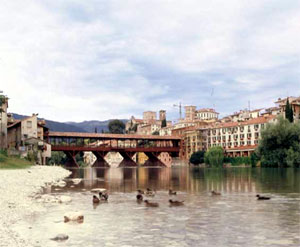 I really liked the location, the fresh air, the
fast flowing river and the picturesque bridge. If you like to be
slightly off the tourist track and would prefer a more rural
setting for short break or as a base for a touring holiday,
Bassano is ideal.
I really liked the location, the fresh air, the
fast flowing river and the picturesque bridge. If you like to be
slightly off the tourist track and would prefer a more rural
setting for short break or as a base for a touring holiday,
Bassano is ideal.
How to get there
The nearest airports are Treviso, used by Ryanair as its airport for Venice and Venice Marco Polo. You could hire a car from the airport. It is possible to reach Bassano by train on the Vicenzia – Trento or Padova – Bassano lines.
History
It is often assumed that the city takes its name from the well known liqueur Grappa. This is not the case; it is named after Monte Grappa. The mountain's name is said to originate from crapp or greep, meaning crag in an ancient pre-Latin language. The liqueur Grappa's name stems from grappolo, meaning a cluster of grapes.
Grappa liqueur has been produced in Bassano since 1779 when Bortolo Nardini bought a Grapperia on the Brenta River bank. Grappa is made from the by-products of wine making, the seeds, stems and skins. The company is still run by members of the Nardini family, accounting for around one quarter of annual grappa production.
Ponte Vecchia has become synonymous with Bassano. 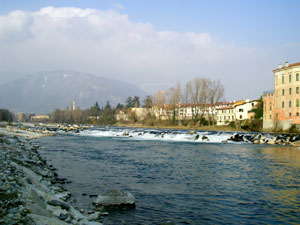 The bridge
is first mentioned in the 11th century. The bridge has been
rebuilt several times due to flooding or destruction during wars.
It is still the original design by Palladio from 1569. The bridge
is built of wood, making it more resilient to the fast flowing
River Brenta.
The bridge
is first mentioned in the 11th century. The bridge has been
rebuilt several times due to flooding or destruction during wars.
It is still the original design by Palladio from 1569. The bridge
is built of wood, making it more resilient to the fast flowing
River Brenta.
There is a record of the city on St Mary's Hill from the 10th century. From the 14th to 18th century the city was under Venetian rule. It became well known for the manufacture of ceramics, wool, silk, iron and copper. The Remondini family ran one of the most up to date printing houses in Europe from the17th to the 19th century.
The Town Hall was first constructed in1405. Bartolomeo Ferranci installed the present clock mechanism in 1743. The interior walls are adorned by frescoes of 120 coats of arms.
White asparagus was first produced in the 16th century after Bassano experienced a hailstorm which destroyed the asparagus crop. The farmers dug up the part of the plant below the earth and discovered that it was so tender and delicious that they started to grow it underground permanently.
Parolini, a local nobleman, designed the Giardini Parolini in the early 19th century. In 1829 Parolini catalogued 3000 plant species in the garden.
During the First World War the Italians took a last stand against the Austrians in Monte Grappa where they entrenched themselves in tunnels and bunkers to repel the Austrian attackers. Over 12,000 Italian and 10,000 Austrian soldiers lost their lives in the numerous battles.
During the Second World War Italian partisans hid in Monte Grappa, organising raids on the main supply route from Germany to the German troops stationed in Italy. In 1944 the Germans took revenge by marching up the mountain behind women, children and elderly local inhabitants. Any partisans discovered or civilians suspected of assisting partisans were killed. There were public hangings and shootings with families forced to watch.
In 1946 the Italian prime minister awarded Basssano the gold medal for military valour. Every year the city commemorates these events during September.
The Museo degli Alpini was established in 1948 in memory of the Italian Alpine Troops It is located on the eastern side of the Ponte Vecchio. You have to enter it through a cafe. I found this rather confusing but the museum is down stairs to the left when you enter the cafe. Originally the collection was very small but has grown as more war relics have been gathered together. There are many original photos, uniforms and armoury.
Museo della Cermica is near the eastern side of the Ponte Vecchio. The building was constructed as the residence of Ferrari family, owners of a local silk factory. The entrance hall is adorned with a fresco by Giorgio Anseli. There are pieces of engraved ceramics from medieval times, Mainardi majolica pieces from the 17th and 18th century, along with modern pieces.
The Civic Musuem is one of the oldest in the Veneto region. It was built in1828 on the site of the convent of St Francis. It houses a collection of paintings by the Da Ponti family, Guariento and Magnasco, a collection of prints by the Remondini family. There is also an archaeological section and pieces by Antonio Canova.
Bassano boasts several churches. San Donato was built in 1208. It is claimed that St Francis of Assisi and St Anthony of Padua both stayed here during the third decade of the 13th century. The church was a hospital, run by Benedictine nuns in the 14th century, then a Fransican monastery during the 15th century. The church was restored in 1900, including work being done on the cell which was used by the two saints.
The Church of San Francesco was started in the mid 12th century, after the return of Ezzelino 11, the Stutterer, from the Holy Land. The Church of St John the Baptist was originally built in 1308 but reconstructed in the 18th century by local architect Giovanni Miazzi. Giambattista Piazzetti made the altarpiece of John the Baptist and Orzio Marinali created the statues of angels and the bas-reliefs.
The Cathedral of Holy Mary was a 10th century parish church in the original high part of the town. The present cathedral dates from the 17th century. The high altar piece and the painting of St Stephen are the work of Leandro di Ponte, and the sculptures are by Mainali. Di Giacomo Dacci made the organ and the three ceiling paintings are by Volpata.
Day trips
Marostica
Marostica is a 14th century medieval town where the original town
wall stands intact. It is best known as the “town of
chess”. Every second year a match, with people dressed in
elaborate costumes to portray the pieces, is played on the giant
chessboard below the castle. This takes place on the second
Friday, Saturday and Sunday every second year, when the year ends
in an even number. This commemorates the chess match played in
1454 when the victor was to win the hand in marriage of Lianora,
the daughter of the Lord of the Castle of Marostica. Two suitors,
Rinaldo d'Angarano and Vieti da Vallonara, had fallen in love
with Lianora and were to fight a duel to see how would marry
Lianora. The Lord forbade the duel and order decreed that the
victor of the chess match would marry Lianora. However all was
not lost for the defeated suitor, as he would marry Lianora's
younger sister, Oldrata. The period costumes are permanently
displayed in the Lower Castle. 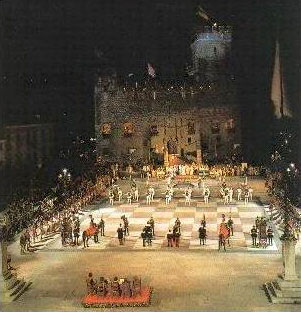
Marostica holds a Cherry Festival every year during May and June. There are kiosks in the streets selling a variety of cherries including morello, roame, marostagne and sander. There is an annual exhibition of comic cartoons in the town. Every July and August local craftsmen display their work the exhibition hall of the Lower Caste. There are some lovely walks through the surrounding hills.
Asola
Asola is a charming hilltop town, with a castle, a cathedral with a altar piece by Lorenzo Lotto and the 15th century Palazzo della Ragione. It was called the “city of one thousand horizons” by Giosue Carducci, because of all the fantastic views. It was much favoured by the Venetian nobility. Caterina Corona, the former Queen of Cyprus, lived here in the late 15th century. Robert Browning, the English poet, bought a house ere in the mid 17th century. Eleanora Duse, credited with being the greatest actress of the Italian stage was also a resident. The travel writer Freya Stark was brought up in Asolo and spent a lot of time here between her various expeditions. There is an antiques market every second weekend of the month, except during July and August.
Karen Bryan is an independent travel consultant and writer, specialising in less well known destinations in Europe. Her websites are: www.europealacarte.co.uk, www.europe-culture-activity-tours
Fave Website
Spotted by webmaster Paul: “Because your first trip to Tokyo can be like going to another planet.
Planet Tokyo is here to guide you through the culture shock that many western travellers experience upon arrival in Japan. If you're planning a trip, or just hoping to learn something new and interesting in this western traveller's guide to Japan” http://www.planettokyo.com/
Venice Barriers to Go Ahead
Italy's Prime Minister Silvio Berlusconi has agreed that work on an underwater dam to try to save the lagoon city of Venice from floods will go ahead, despite increasing calls for it to be halted because of environmental damage. Work on the project known as Mose, Italian for Moses, began in 2003. Designers hope the construction of underwater barriers will protect the fragile canal city from the ravages of the sea. The project aims to construct 78 flood barriers, 20 metres (65 feet) wide and up to 28 metres (92 feet) high, that will be fixed to the bed of the sea at points where Venice's lagoon meets the Adriatic. Venice's mayor Massimo Cacciari, supported by environmentalists and Venetian elders, had asked Berlusconi to consider other measures, arguing the barriers would cause as much damage to Venice as they prevent. The World Wildlife Fund Italy has said that shutting Venice's cargo port and barring cruise liners from entering the lagoon would be more effective in controlling the waters. There are also concerns about the cost of the scheme.
Eleven Reasons to get Married in Scotland by Charlie Taylor
Scotland has been a favourite holiday destination for many years and now it has a growing reputation as a favourite destination for couples from around the world to tie the knot. Here are the eleven main reasons:-
1 There are no residency requirements. Couples from anywhere in the world can get married in Scotland. You don't have to live here. You don't need UK citizenship. All you have to do is complete the necessary legal formalities and you can marry within 24 hours of arriving here.
2 You can get married anywhere – absolutely anywhere – in the country. On a beach, in a castle, up a mountain, in a hotel, by a loch… your choices are limitless.
3 You can opt for a civil or a religious ceremony. The civil ceremony is more restrictive as regards your choice of venue because they have to be licensed by the local authority. But there are now so many venues licensed for civil ceremonies that, in practice, you will always find somewhere to match your dream.
4 A religious ceremony, conducted by a minister can be held anywhere. I have known them to be held on boats, in lighthouses and even on cliff-tops! Obliging and occasionally daring ministers can always be found.
5 Ceremonies can even be conducted by non-religious celebrants, including certain officers of the Humanist Society.
6 The choice of venues is staggering. From sophisticated Glasgow to traditional Edinburgh; from the rugged, breathtaking beauty of the Highlands to the Ayrshire coast; from imposing castle to pretty little village church, Scotland has it all.
7 You can fly into Glasgow, Prestwick, Edinburgh, Aberdeen or Inverness airports and be close to your wedding venue from the start.
8 So many people around the world have Scottish ancestry and love to search out their roots.
9 What better clothes to wear at your ceremony than the kilt, made especially for you in your own tartan.
10 And what better accompaniment as the bride enters the wedding venue than a Highland wedding tune played on bagpipes!
11 And after the ceremony, what better way to toast the health of the bride and groom than with a single malt whisky from a Scottish quaich in the country where it is made!
The truth is, there are lots of reasons for you to hold your wedding ceremony in Scotland. If you are in love, Scotland is the place for you. If you believe in romance, Scotland is the place for you. If you long for the mystery of the lochs, the glens, the castles and the mountains, Scotland is the place for you.
Charlie Taylor is one of the founders of Highland Country Weddings Ltd, a Scottish weddings agency with an international dimension. For more information, please visit
Journalism a Dangerous Job
An independent media watchdog group, the Committee to Protect Journalists, (CPJ), says press freedom was under siege in every corner of the globe last year. The CPJ says Iraq remained the most dangerous place in the world to work as a journalist in 2004. In its annual report, entitled “Attacks on the Press,” the CPJ said 56 journalists were killed worldwide last year as a direct result of their work.
At least 23 journalists and 16 media support workers were killed in Iraq last year. Another 22 journalists were abducted while trying to report on the Iraq conflict. 122 journalists were imprisoned in 2004, three-quarters of them in just four countries – China, Burma, Eritrea, and Cuba.
Eight journalists were murdered in the Philippines last year, allegedly for criticizing the government or reporting on corruption.
Eleven journalists have been killed in contract-style killing since President Vladimir Putin came to power.
Zimbabwe was named one of the world's worst places to be a journalist because of the government's continued crackdown on private media and Bangladesh was found to be the most dangerous county in South Asia for the media.
Been In Prison Overseas?
Philip recently contacted us to say that he is an English producer currently putting together a film about British citizens who are or have been imprisoned abroad. Perhaps, you remember someone who planned something, or in a moment of madness decided to do something, that ended up with a prison term?
They type of story I'm looking for is one about people – 'normal people' faced with a life-changing opportunity and who were possibly convinced it was going to work out? Was it all going to plan when suddenly it went wrong – ending in the shock of going to prison? If you think you've even heard of a story – possibly where somebody remains in jail abroad, I'd be extremely grateful to hear from you. I can be contacted on: philip@rawtelevision.co.uk
